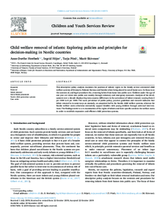Displaying 561 - 570 of 2163
The objective of this study was to examine the utility of child protective services data in identifying predictors of placement disruption.
The article is based on interviews with 22 children’s spokespersons in the Norwegian arrangement for indirect participation in care proceedings, and presents analyses of the spokespersons’ experiences of contradictions and dilemmas in their practices.
This research examined the impact of individual and relational characteristics of foster parents on permanency outcomes for children in care.
This descriptive policy analysis examines the position of infants’ rights in the family service orientated child welfare systems of Denmark, Finland, Norway and Sweden when being placed in out-of-home care.
Children who enter out-of-home care are at risk for trauma and behavioral problems, however the child welfare and behavioral health systems do not effectively communicate to provide evidenced-based treatment. This case study describes a project that addressed these concerns.
The thesis consists of four interrelated empirical studies that address different aspects of poor educational outcomes among children with out-of-home care (OHC) experience by means of analyses of longitudinal survey and register data, and evaluations of two interventions aimed at improving their basic academic skills.
The purpose of this study was to examine factors related to unintentional child injury requiring medical attention, including child welfare placement type, child behavioral problems, caregiver characteristics, and neighborhood factors.
This chapter from the book Education in Out-of-Home Care reviews available evidence, drawing on a recent small-scale English research study to explore the potential of early education as an intervention for children in care.
This chapter from the book Education in Out-of-Home Care outlines the skills that are necessary for a successful start to formal schooling for children placed into out-of-home care (OHC).
This chapter from the book Education in Out-of-Home Care reviews the available research on issues related to early childhood education and care (ECEC) for children in foster care in Australia and reports findings on the ECEC experiences of 60 children aged 3 to 5 years from the Australian Early Childhood in Foster and Kinship Care study.


